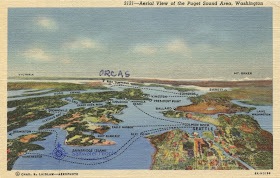 |
| Puget Sound Ports leading to the world. Click map image to enlarge. |
 |
| Getting closer to home, Click the image to enlarge. Map cards from the archives of the Saltwater People Historical Society© |
"From the first records to the present day the fishing and its industry have always been a most important factor in the development of this county. About 1850, numbers of small fishing sloops would fish around the southerly part of San Juan Island. They would anchor in what is now charted as Griffin Bay [formerly San Juan Harbor.] They prepared their fish for salting in barrels, that they sold to the Hudson's Bay Co., at Victoria, B.C. This being such a convenient haven some of them built shacks ashore and as the number grew, small schooners would come and gather up the barreled fish. This was probably the first freighting out of the islands. The shantytown grew and a man called Captain Higgins put in a small stock of supplies. Fishermen wrote letters and left them with him for mailing to Victoria. They gave as a return address, 'Victoria, care of Capt. Higgins, San Juan town,' and thus was born the first town in the county. Many Native American maidens kept house for the fishermen. In time there were two stores with liquor in the backroom, and rooms to rent on the upper floor, and fairly regular mail service. This first town was finally abandoned and was later destroyed by fire, but during the days of the boundary dispute, it was a lively place and high-life a-plenty.
The fishing industry had a steady development. A fish saltery was built near Friday Harbor. A few years later it was destroyed by fire. Shortly after this loss a packer from the Columbia River, named Develin, built a cannery at Friday Harbor, San Juan Island. Fish traps were introduced and many of these made big money for their owners––and on the hush-hush, they often made money for the fish-pirates, too.
 |
| Fish trap fishing Pacific Northwest Washington. The top photo is a trap in Point Roberts, WA. Click image to enlarge. |
 |
| FISH TRAP LOCATIONS IN NORTHERN PUGET SOUND DATED 1913. Click image to enlarge. |
 |
| Fish trap westside of San Juan Island, WA. Click image to enlarge. From the archives of the Saltwater People Historical Society© |
The first seiners were all hand-operated, but the advent of gasoline-powered engines soon put them out of the running.
 |
| Puget Sound seine fishermen hand-hauling in the net. Low res scan of original photo dated 1943. From the archives of the Saltwater People Historical Society© |
 |
| Reefnet fisher Ed Hopkins. Day's end on the fish boat, one of the pair of boats comprising his gear #7. Squaw Bay, San Juan County, WA. 1980s. |
 |
| Fish in the net, Gear #7 Squaw Bay, Shaw Island, WA. Ed Hopkins and crew Jim Sesby. Click image to enlarge. Photos courtesy of gear owners Ed & Kathy Hopkins. |
At one time there were seven or more canneries operating in this county, now there are only two in this year of 1953.
 |
| Friday Harbor Waterfront Undated. |
Quicker transportation, modern transportation, and machines that are so marvelously skillful and tireless have made a great change in the canning industry. Now, too, the top market for the highest grade is here in the United States. At one time the highest prices were obtained in England. In the early 1900s, a British bark was towed into Friday Harbor cannery and loaded most of the pack for delivery in England. In those days the humpbacks were not even canned, but thrown overboard, thousands and thousands of them.
Lime is one of the major natural assets in the county and has made a major contribution in the wealth and development of San Jan county, and probably bids fair to outrun all industries, other than agriculture. Many an early settler while clearing his land and getting his farm in shape, was glad to put in off-time at cutting and hauling cordwood for the lime kilns.
 |
| Lime manufacturing Roche Harbor, San Juan Island Click image to enlarge. Original photos from the archives of the Saltwater People Historical Society© |
The first lime was probably burned by some of the English soldiers who were familiar with the industry. They built some small pot kilns and barreled the lime they made in empty beef casks and traded it to the Hudson's Bay Co. With the packaging of the lime, there came quite a development in coopering. This, too, was a gainful occupation that could be worked at during the off days from the seasonal farm work. Nearly all the early steamers were wood burners. The cutting and hauling of cordwood to the different boat landings furnished a considerable payroll. No one in those days would have believed that there would be ferry boats or any craft over 250-ft long making daily trips through the Islands. And what of the future –– who knows."
Words by Mr. Frank Mullis., from a pioneer family of San Juan Island, WA. for the Friday Harbor Journal Nov. 1956. Maps, chart, photographs from the archives of the Saltwater People Log.

No comments:
Post a Comment